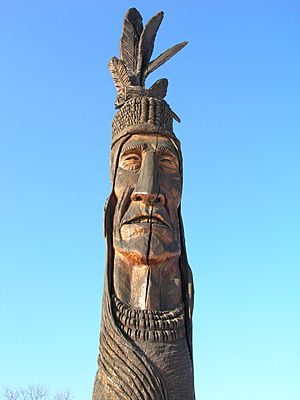Grey Lock's War facts for kids
Quick facts for kids Grey Lock's War |
|||||
|---|---|---|---|---|---|
| Part of Dummer's War | |||||
 Monument of Chief Grey Lock in Battery Park (Burlington, Vermont) |
|||||
|
|||||
| Belligerents | |||||
| Abenaki | |||||
| Commanders and leaders | |||||
| Massachusetts Governor William Dummer | Gray Lock | ||||
Grey Lock's War was a part of a larger conflict called Dummer's War in the 1720s. This war took place in northern New England. It was named after Grey Lock, a skilled Abenaki leader. He became famous for his clever fighting style.
Grey Lock used guerrilla warfare tactics. This means he led small groups of warriors in surprise attacks. They would hit quickly and then disappear. This made it very hard for his enemies to catch him. Because he was so good at avoiding capture, he earned the name Wawanolet. This name means "he who fools the others."
Unlike many wars of that time, Grey Lock's War was not mainly about France and England fighting. Often, local Native Americans were caught in the middle of these bigger European conflicts. But Grey Lock's War was different. The Native Americans fought for their own reasons and goals.
Grey Lock later formed an alliance with the French. Old records from Fort Saint-Frédéric show the French knew him as "la Tête Blanche," meaning "White Head." He became a Catholic and was baptized with the French name Pierre-Jean. His wife was named Hélène. They had two children, Jean-Baptiste and Marie-Charlotte. Today, some of Grey Lock's family still carry the name Wawanolet.
Contents
Understanding Grey Lock's War
This section will explain the key events of Grey Lock's War. It covers the main battles and raids led by Grey Lock. You will learn how the conflict started and how it developed over time.
How Did the War Begin?
The conflict officially started on July 25, 1722. The Governor of Massachusetts, Samuel Shute, declared war on the Abenaki people. Governor Shute had disagreements with the Massachusetts assembly. He suddenly left for England on January 1, 1723. This left Lieutenant Governor William Dummer in charge of the war efforts in Massachusetts.
Key Battles and Raids
Grey Lock played a major role in many attacks during the war. His actions often led to responses from the New England colonies.
First Attacks in 1723
Grey Lock first joined the war on August 13, 1723. He led a raid on Northfield, Massachusetts. His warriors killed two people near the town. The very next day, they attacked Joseph Stevens and his four sons in Rutland. Stevens managed to escape. However, two of his sons were killed, and the other two were captured.
On October 9, 1723, Grey Lock attacked two small forts. These forts were located near Northfield. His forces caused injuries and took one person captive. In response to these attacks, Governor Dummer ordered a new fort to be built. This fort was named Fort Dummer. It was built where Brattleboro, Vermont is today.
Fort Dummer and More Raids
Fort Dummer became a very important base for soldiers. They used it to scout the area and launch expeditions into Abenaki territory. It was also the first permanent European settlement in what is now Vermont. Lieutenant Timothy Dwight was in command of the fort.
On June 18, 1724, Grey Lock attacked a group of men. They were working in a field near Hatfield, Massachusetts. After this attack, Grey Lock moved to other areas. Over the summer, he led more attacks. Men were killed in Deerfield and Northfield.
Governor Dummer reacted by sending more soldiers. They were sent to Northfield, Brookfield, Deerfield, and Sunderland. Interestingly, Grey Lock's home village of Woronoke was not attacked. This village is now part of Westfield and Russell.
Final Skirmishes
On October 11, 1724, about seventy Abenaki warriors attacked Fort Dummer. During this attack, three or four soldiers were killed.
In September 1725, a small group of six soldiers left Fort Dummer. They were on a scouting mission. Grey Lock and fourteen of his warriors ambushed them. This ambush happened west of the Connecticut River. Two soldiers were killed, and three were wounded and captured. One soldier managed to escape. During the fight, two Native American warriors were also killed.

